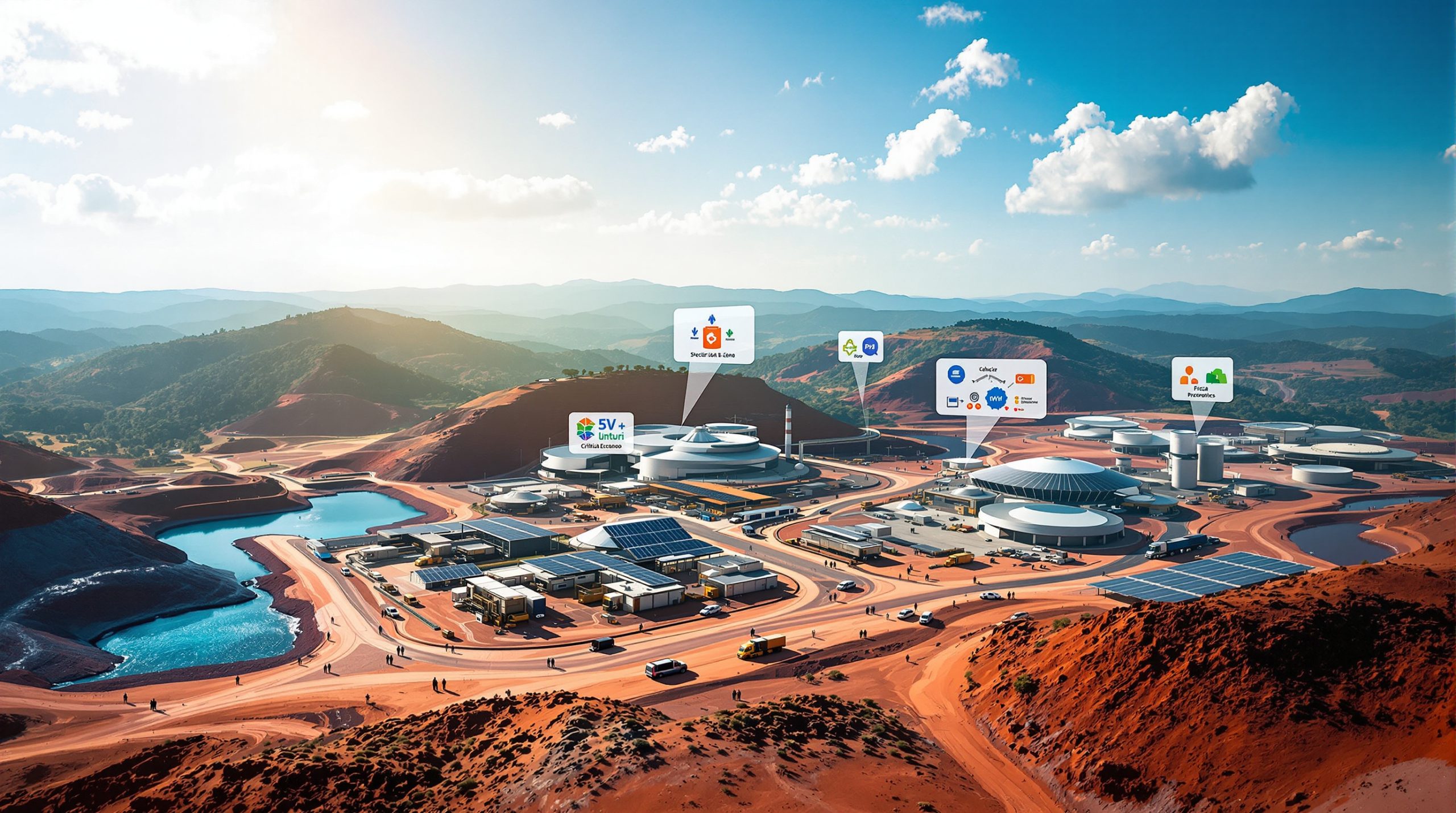Strategic Mineral Sovereignty: Building National Security Through Critical Resource Control
How Is Global Mineral Security Being Redefined?
The global race for critical minerals has transformed from a commercial competition into a national security imperative. Nations worldwide are implementing strategic frameworks to reduce dependence on concentrated supply chains, particularly those dominated by China. This shift represents a fundamental rethinking of how countries approach mineral resources essential for energy transition, defense capabilities, and industrial competitiveness.
Western nations now recognize that control over critical minerals energy security directly impacts economic security, technological leadership, and military readiness. The strategic vulnerability created by concentrated supply has prompted comprehensive policy responses aimed at developing domestic capabilities and forming international partnerships based on shared values and interests.
Governments are increasingly viewing critical minerals through the lens of national resilience, establishing formal frameworks that classify certain materials as strategically essential. These designations trigger specialized policy support including expedited permitting, financial incentives, and research funding targeted at addressing specific supply chain vulnerabilities.
Why Are Countries Prioritizing Mineral Independence?
The Vulnerability of Import Dependence
Western nations face unprecedented supply chain vulnerabilities in critical minerals essential for clean energy and defense technologies. The United States currently imports over 95% of its processed lithium despite possessing significant domestic resources. This dependence creates strategic weaknesses that governments are now addressing through comprehensive policy frameworks and investment initiatives.
The risks of import dependence extend beyond simple supply disruptions to encompass potential economic coercion, quality control challenges, and innovation constraints when processing capabilities remain concentrated overseas. Companies operating in import-dependent nations face planning uncertainties that complicate long-term capital allocation decisions for manufacturing facilities reliant on processed mineral inputs.
Recent supply disruptions in various mineral markets have demonstrated the real-world consequences of overdependence. When Indonesia restricted nickel exports and Guinea experienced political instability affecting bauxite production, manufacturers faced material shortages and price volatility that directly impacted production schedules and profitability.
The Concentration of Processing Capacity
China's dominance in mineral processing represents perhaps the most significant chokepoint in global supply chains. With control over 80% of global lithium processing capacity and similar dominance in rare earth element refining, China wields extraordinary influence over materials essential to energy transition technologies. This concentration has prompted Western nations to develop alternative processing infrastructure through public-private partnerships.
The processing bottleneck creates a critical vulnerability even when mining occurs in friendly jurisdictions. Raw materials extracted in Australia, Canada, or the United States often still travel to China for processing before returning as finished products, creating a circular dependence that undermines security objectives.
The technical expertise required for advanced mineral processing has historically been concentrated in a limited number of companies and countries, creating barriers to rapid capability development. Nations are now investing in knowledge transfer programs, technical education initiatives, and research partnerships to rebuild processing expertise domestically.
The National Security Dimension
Critical minerals have become central to defense capabilities, with rare earth elements used in precision-guided weapons, communication systems, and advanced electronics. The Pentagon has identified mineral supply chain vulnerabilities as a significant national security risk, leading to targeted investments in domestic processing capabilities through the Defense Production Act and other mechanisms.
Military planners now recognize that access to specialized materials directly impacts operational readiness and technological superiority. Defence-critical minerals increasingly rely on materials with unique properties that cannot be easily substituted, creating strategic vulnerabilities when those materials come from potentially adversarial nations.
The intersection of civilian and military applications for many critical minerals creates unique policy challenges. Technologies essential for renewable energy deployment often require the same materials used in defense applications, necessitating coordinated approaches that balance commercial markets with strategic stockpiling and dedicated supply agreements.
What Strategies Are Nations Employing to Achieve Mineral Sovereignty?
Domestic Processing Infrastructure Development
Nations are rapidly expanding domestic processing capacity to overcome the bottleneck between mining and manufacturing. In the United States, companies are developing domestic processing facilities with capacities of 50,000+ tons annually, representing a significant expansion from current domestic production of approximately 20,000 metric tons. These facilities utilize proven, off-the-shelf technologies to minimize innovation risk while enabling rapid deployment.
The focus on proven technologies reflects a strategic choice to prioritize speed and reliability over potentially disruptive but unproven innovations. Companies are adapting established processing methods to local conditions while incorporating incremental improvements that enhance efficiency without introducing significant technical risk.
Domestic processing facilities typically incorporate design elements that facilitate future expansion, allowing initial production modules to establish operational track records and generate cash flow while providing platforms for subsequent capacity growth. This phased approach manages capital deployment risk while creating clear pathways to scale.
Strategic Public-Private Partnerships
Governments are creating unprecedented financial incentives to accelerate critical mineral project development. State-level incentives exceeding $250 million for individual processing facilities demonstrate the priority placed on establishing domestic supply chains. These incentives can represent 50% or more of initial construction costs, substantially improving project economics while accelerating development timelines.
The partnership models extend beyond direct financial support to include specialized permitting pathways, infrastructure development, workforce training programs, and research collaborations. This comprehensive ecosystem approach addresses multiple development constraints simultaneously while creating supportive environments for sustained industry growth.
Public entities are increasingly willing to accept pricing and offtake commitments that provide demand certainty for new projects, even when those terms may temporarily exceed international market prices. This "security premium" reflects recognition that establishing domestic capabilities delivers strategic benefits beyond simple commercial calculations.
Regulatory Streamlining and Fast-Track Approvals
Permitting reform has become a central component of mineral sovereignty strategies. Countries are implementing specialized regulatory pathways for critical mineral projects, reducing approval timelines from 5+ years to 18-24 months in many cases. These reforms maintain environmental standards while recognizing the strategic importance of timely project development.
The streamlining approaches typically include early engagement between developers and regulators, concurrent review processes that replace sequential approvals, and dedicated staff resources assigned to priority projects. These procedural improvements reduce administrative delays while maintaining substantive regulatory requirements.
Regulatory agencies are developing specialized expertise in critical mineral processing technologies to enable more efficient review processes. This technical capacity building allows for more informed assessment of environmental control systems and mitigation measures specific to different mineral processing methods.
International Alliance Building
Western nations are forming strategic mineral alliances to diversify supply chains beyond individual national boundaries. The Minerals Security Partnership, launched in 2022, coordinates investment and policy approaches among democratic nations to develop resilient supply chains outside Chinese control. These alliances enable more efficient capital deployment while creating larger markets for critical mineral products.
Partner countries typically share core values regarding environmental standards, labor practices, and governance transparency, creating common frameworks that facilitate project development across multiple jurisdictions. These shared standards reduce regulatory complexity while ensuring responsible resource development practices.
Alliance members often coordinate research and development initiatives targeting specific technical challenges in critical mineral processing. This collaboration spreads development costs while accelerating technological advances that can benefit multiple partner nations simultaneously.
How Does Processing Technology Drive Mineral Independence?
Innovative Extraction Methodologies
Advanced processing technologies are enabling countries to develop resources previously considered uneconomic. In-situ recovery techniques for rare earth elements operate at benign pH levels (equivalent to black coffee), minimizing environmental impacts while producing high-value concentrates. These approaches can reduce capital requirements by 60-70% compared to conventional mining methods while accelerating time to production.
The environmental profile of these advanced techniques often enables development in jurisdictions with stringent regulatory standards that might otherwise prohibit conventional processing approaches. Lower footprint operations with minimal waste generation can access resources closer to existing infrastructure and end markets.
The adaptability of these technologies to different geological settings enables application across diverse resource types, potentially unlocking vast resources previously considered inaccessible. This flexibility creates multiple pathways to expand domestic production without reliance on a single deposit type or region.
Metallurgical Breakthroughs
Metallurgical innovations are transforming the economics of critical mineral production. Early-stage separation processes that remove lower-value elements like cerium and lanthanum can increase concentrate values by 30-40%, improving project economics while focusing production on the most strategically important materials. These approaches enable profitable production across a wider range of commodity price scenarios.
Advanced separation technologies can selectively target specific elements within complex mineral assemblages, creating customized product streams tailored to different market applications. This specialization enables producers to command premium pricing while developing long-term customer relationships based on unique product characteristics.
Process flowsheets increasingly incorporate modular designs that enable sequential implementation and progressive optimization. This approach reduces initial capital requirements while creating opportunities to incorporate technological improvements as operations mature.
Value-Added Processing Capabilities
Countries are prioritizing development of complete value chains from mining through advanced materials production. Integrated approaches that progress from mineral concentrates to battery-grade chemicals command significant pricing premiums while creating additional manufacturing opportunities. This vertical integration captures more economic value domestically while reducing vulnerability to international supply disruptions.
The progression from basic mineral concentrates to specialized materials creates exponential value increase, with battery-grade lithium compounds commanding 5-7 times the price of basic lithium concentrates. This value multiplication provides compelling economic incentives for domestic processing while supporting multiple layers of industrial activity.
Advanced processing capabilities attract downstream manufacturing investments, creating industrial clusters that benefit from proximity and supply chain integration. These ecosystems develop specialized workforces while fostering innovation through knowledge sharing and supplier development.
What Economic Frameworks Support Mineral Sovereignty?
Government Financing Mechanisms
Export credit agencies and development banks have established specialized financing programs for critical mineral projects. These mechanisms can provide 75-80% debt financing for qualified projects, substantially reducing equity requirements while accelerating development timelines. The favorable financing terms reflect the strategic importance of these projects to national security and economic competitiveness.
The specialized financing programs typically feature extended tenure, below-market interest rates, and flexible covenant structures that accommodate the unique development timelines of mineral processing facilities. These tailored approaches reduce financing costs while providing appropriate risk allocation between public and private stakeholders.
Government-backed financial instruments often incorporate specific incentives for projects demonstrating exceptional environmental performance, community benefits, or technical innovation. These targeted enhancements reward projects exceeding baseline requirements while encouraging continuous improvement in industry practices.
Phased Development Approaches
Companies are implementing staged development strategies that provide multiple value inflection points while managing capital deployment risk. Initial production modules generating positive cash flow can fund subsequent expansion phases, reducing dilution while demonstrating operational capabilities. Each expansion phase typically improves economies of scale while maintaining flexibility to adapt to evolving market conditions.
The phased approach enables projects to establish technical and commercial proof of concept at manageable scale before committing to full production capacity. This graduated implementation reduces technology risk while creating opportunities to incorporate learnings from initial operations into subsequent expansion designs.
Modular expansion pathways provide flexibility to respond to changing market dynamics, with capacity additions timed to match evolving demand patterns. This adaptability reduces the risk of overcapacity during market downturns while positioning operators to capture growth opportunities during demand expansions.
Premium Product Positioning
Superior product quality creates sustainable competitive advantages in critical mineral markets. High-grade deposits with 4-6 times better grades than international competitors enable robust economics across commodity price cycles. Similarly, products with lower impurity levels command pricing premiums while reducing processing costs for customers, creating mutual value that supports long-term relationships.
The quality differentiation extends beyond simple grade advantages to encompass impurity profiles, physical characteristics, and consistency parameters that directly impact customer operations. Products tailored to specific downstream applications can command 15-25% pricing premiums while establishing preferred supplier status.
Strategic positioning within specialized market segments creates defensible competitive positions less vulnerable to commodity price cycles. Products targeting high-specification applications typically experience less price volatility than generic commodities, providing more stable cash flow profiles for producers.
How Are Resource-Rich Nations Maximizing Sovereign Benefits?
Domestic Value Addition Requirements
Resource-rich countries are implementing policies requiring domestic processing of minerals before export. These approaches aim to capture more economic value from natural resources while developing advanced manufacturing capabilities. The policies typically include graduated implementation timelines that allow for infrastructure development while providing clear investment signals.
The value addition requirements often incorporate incentive structures that reward investments in processing capabilities through preferential royalty rates, tax treatments, or infrastructure access. These progressive frameworks create economic benefits for companies investing in domestic processing while supporting national development objectives.
Leading jurisdictions have developed collaborative approaches that engage industry stakeholders in policy design to ensure requirements align with technical and economic realities. This consultation process creates more sustainable frameworks that balance national objectives with investor requirements for predictable operating environments.
Strategic Infrastructure Control
Integrated infrastructure ownership provides competitive advantages while creating additional revenue opportunities. Companies controlling rail, port, and processing facilities can optimize logistics costs while potentially offering services to third parties. These integrated approaches enable cost control while creating defensive market positions that are difficult for competitors to replicate.
The infrastructure control extends beyond physical assets to encompass specialized logistics capabilities, digital systems, and operational expertise that collectively create sustainable competitive advantages. These capabilities enable reliable delivery of consistent-quality products while reducing operational variability.
Strategic infrastructure positioning creates natural barriers to entry that protect market positions while providing platforms for expansion into related product categories. Control of key transportation nodes or processing hubs creates opportunities to consolidate regional production while optimizing capital efficiency.
Sustainable Development Frameworks
Nations are implementing comprehensive frameworks that balance mineral development with environmental and social considerations. These approaches recognize the essential role of critical minerals in global sustainability while ensuring development benefits local communities. Transparent governance mechanisms ensure equitable distribution of benefits while maintaining international competitiveness.
The sustainability frameworks increasingly incorporate circular economy principles that maximize resource utilization while minimizing waste generation. Integrated approaches to water management, energy efficiency, and materials recovery create operations with reduced environmental footprints while improving economic performance.
Leading jurisdictions are developing specialized fiscal regimes that balance investment incentives with appropriate public returns. These frameworks typically include stability provisions that protect investor expectations while incorporating flexibility mechanisms that adapt to changing market conditions over multi-decade project lifespans.
What Are the Investment Implications of Mineral Sovereignty?
Supply Security Premium
Projects addressing critical supply chain vulnerabilities command valuation premiums reflecting their strategic importance. Domestic processing facilities in Western nations can secure preferential offtake agreements with manufacturers seeking supply chain diversification. This strategic positioning enables more favorable financing terms while potentially supporting higher valuation multiples.
The security premium manifests through multiple commercial advantages including longer contract durations, higher pricing floors, and more flexible volume commitments than typically available in purely commodity markets. These enhanced commercial terms reflect the strategic value that secure supply represents to customers facing their own downstream commitments.
Financial markets increasingly recognize the differentiated risk profiles of strategically positioned projects compared to conventional commodity producers. Companies with established positions in critical mineral supply chains often trade at enterprise value premiums of 30-50% compared to producers of traditional commodities with similar production profiles.
Government Policy Alignment
Companies developing projects aligned with national security priorities benefit from unprecedented policy support. Beyond direct financial incentives, these projects often receive preferential treatment in permitting processes, infrastructure development, and workforce training programs. This comprehensive support reduces development risk while accelerating time to production.
The policy alignment creates tangible competitive advantages through reduced development timelines, lower capital costs, and enhanced operational predictability. Projects with clear strategic importance can progress from initial concept to production in 3-5 years compared to 7-10 years for conventional mining developments without similar priority designations.
The collaborative relationship with government agencies creates ongoing opportunities to shape regulatory frameworks, influence policy development, and access specialized support programs. This strategic partnership position provides sustainable advantages that extend beyond initial project development into operational phases.
Multiple Value Catalysts
Companies implementing phased development approaches provide investors with regular value inflection points. Completing engineering studies, securing permits, commencing construction, and achieving first production represent clear milestones that can drive valuation rerating. The sequential achievement of these milestones demonstrates execution capability while reducing overall project risk.
The defined development pathway enables more precise valuation analysis compared to early-stage exploration companies or speculative technology ventures. Projects with completed feasibility studies, secured permits, and construction financing typically trade at substantial premiums to earlier-stage opportunities with similar ultimate potential.
The milestone-based progression creates natural investment entry and exit points aligned with different risk preferences and investment horizons. This liquidity profile attracts diverse investor types from specialist resources funds to generalist institutions seeking exposure to energy transition themes.
How Does Product Quality Differentiate Critical Mineral Projects?
Grade Advantages
Exceptional deposit grades provide sustainable competitive advantages in critical mineral markets. Projects with grades 4-6 times higher than competing operations demonstrate robust economics across commodity price cycles. These grade advantages typically translate to lower production costs, higher recoveries, and superior product characteristics.
The economic impact of grade advantages compounds through multiple operational dimensions including reduced processing requirements, lower energy consumption, decreased reagent usage, and minimized waste management. These operational efficiencies can reduce production costs by 30-50% compared to lower-grade operations.
Superior grades often correlate with enhanced recovery rates that further improve economic performance. High-grade operations typically achieve metal recoveries 5-15% higher than lower-grade counterparts, effectively multiplying the initial grade advantage through enhanced processing efficiency.
Metallurgical Performance
Advanced metallurgical processes enable production of higher-value products from the same resource base. Selective removal of impurities can increase concentrate values by 30-40% while improving marketability. These processes typically require modest capital investment while generating substantial returns through improved pricing and expanded market access.
The metallurgical innovation extends beyond simple impurity removal to encompass product characteristics that create downstream processing advantages for customers. Tailored particle size distributions, moisture content specifications, and crystalline structures can reduce customer processing costs while improving end-product performance.
Proprietary metallurgical approaches often create defensible market positions protected by technical expertise rather than patent portfolios. This knowledge-based advantage sustains competitive differentiation while requiring continuous innovation to maintain leadership positions.
Impurity Profiles
Lower impurity levels create significant value for both producers and customers. Rare earth projects with minimal radioactive content can avoid complex regulatory requirements while accessing markets with strict import standards. Similarly, lithium products with lower sodium, calcium, and magnesium levels command pricing premiums while reducing processing costs for battery manufacturers.
The impurity profile directly impacts product application suitability, with lower contaminant levels enabling use in high-specification applications that command premium pricing. Products meeting specialized purity standards can command 20-30% pricing premiums while accessing market segments inaccessible to standard-grade materials.
Customer operations typically achieve substantial processing cost advantages when using lower-impurity inputs, creating mutual value that supports sustainable pricing differentials. These customer benefits include reduced energy consumption, lower reagent usage, extended equipment life, and enhanced end-product performance.
What Challenges Remain in Achieving Mineral Sovereignty?
Technical Expertise Development
Building domestic technical capabilities represents a significant challenge for many nations pursuing mineral sovereignty. The specialized knowledge required for advanced processing operations has historically been concentrated in a limited number of companies and countries. Developing this expertise domestically requires substantial investment in education, training, and knowledge transfer programs.
The technical capability gap extends beyond operational knowledge to encompass process design, equipment engineering, and performance optimization expertise. Comprehensive capability development typically requires 5-7 years of focused investment to establish self-sustaining domestic knowledge bases.
Nations are implementing multi-faceted approaches including specialized university programs, industry-government research partnerships, and international knowledge transfer arrangements. These parallel initiatives aim to develop both immediate operational capabilities and longer-term innovation capacity.
Capital Intensity
Critical mineral processing facilities require substantial upfront investment before generating returns. Initial capital requirements of $400-500 million for commercial-scale operations present funding challenges, particularly for emerging companies. While government support can offset portions of this investment, securing the remaining capital requires innovative financing approaches and strategic partnerships.
The capital intensity creates natural advantages for established companies with existing cash flows, strong balance sheets, and proven development capabilities. Emerging players typically need to demonstrate exceptional asset quality or strategic positioning to attract the substantial funding required for commercial-scale development.
Financial markets are developing specialized funding structures that align with the unique risk profiles and development timelines of critical mineral projects. These approaches include royalty arrangements, streaming agreements, strategic equity partnerships, and hybrid debt instruments that collectively address the capital intensity challenge.
Market Development Timelines
Establishing complete domestic supply chains requires coordinated development of mining, processing, and manufacturing capabilities. The different development timelines for these components can create temporary mismatches between supply and demand, potentially leading to price volatility or temporary oversupply in specific market segments. Strategic planning and phased implementation can mitigate these challenges.
The manufacturing capacity development typically lags resource projects by 1-3 years, creating potential market imbalances during transition periods. Proactive market development initiatives including strategic stockpiling, flexible offtake agreements, and international trading relationships can bridge these temporal gaps.
Industry collaboration through working groups, information sharing platforms, and coordinated planning exercises enables more synchronized development across supply chain segments. These collaborative approaches reduce friction during transition periods while supporting stable market development.
What Future Developments Will Shape Mineral Sovereignty?
Recycling and Circular Economy Integration
Advanced recycling technologies will increasingly complement primary production in critical mineral supply chains. Processes capable of recovering 95%+ of key elements from end-of-life products reduce import dependence while improving environmental performance. These approaches will become increasingly important as the first generation of energy transition technologies reaches end-of-life.
The recycling integration creates resilient supply networks that combine primary production with circular material flows. This hybrid approach reduces reliance on any single supply source while improving resource utilization and environmental performance across the entire value chain.
Leading companies are developing integrated business models that combine primary production with recycling capabilities. This balanced approach creates supply flexibility while positioning operations as complete material solution providers rather than simple commodity producers.
Breakthrough Processing Technologies
Next-generation extraction and processing technologies promise to transform the economics of critical mineral production. Direct lithium extraction technologies can reduce water consumption by 90% while accelerating production timelines from 18 months to 24 hours compared to traditional evaporation methods. Similar breakthroughs in rare earth processing could substantially expand economically viable resource bases.
The technological innovation extends beyond primary extraction to encompass novel separation techniques, advanced purification methods, and specialized product formulation approaches. These innovations collectively expand the resource base while improving recovery rates, reducing environmental impacts, and lowering production costs.
Research initiatives increasingly focus on process intensification that enables smaller footprint operations with reduced energy and reagent consumption. These approaches support distributed production models that can locate processing facilities closer to end markets while reducing logistics costs and supply chain vulnerabilities.
Integrated Supply Chain Development
Countries are increasingly pursuing integrated strategies encompassing the entire value chain from mining through advanced manufacturing. These approaches maximize domestic value creation while reducing vulnerability to international supply disruptions. The coordination of mining, processing, and manufacturing development creates mutually reinforcing capabilities that strengthen overall competitiveness.
The integrated approach aligns infrastructure development, workforce training, and research priorities across multiple industries and government agencies. This coordination optimizes resource allocation while creating industrial ecosystems with substantial productivity advantages.
Leading jurisdictions are developing specialized industrial zones that co-locate related operations while providing shared infrastructure, streamlined permitting, and targeted incentives. These strategic clusters create operational synergies while fostering innovation through proximity and knowledge sharing.
Conclusion: The Path Forward for Mineral Sovereignty
Strategic mineral sovereignty represents a fundamental reshaping of how nations approach critical minerals strategic pivot essential for energy transition and national security. The combination of government policy support, technological innovation, and strategic investment is creating unprecedented opportunities to develop resilient supply chains outside traditional centers of production and processing.
For investors, companies addressing critical supply chain bottlenecks with proven technologies, secured financing, and government support offer compelling opportunities to participate in building essential infrastructure for the energy transition. The strategic importance of these projects supports premium valuations while providing exposure to structural growth in critical mineral demand.
For policymakers, achieving mineral sovereignty requires coordinated approaches that balance immediate security concerns with long-term sustainability objectives. Successful strategies will integrate domestic production with international partnerships while developing complete value chains that maximize mineral beneficiation opportunities.
The pursuit of mineral sovereignty will reshape global supply chains over the coming decade, creating new centers of production and processing while reducing concentration risks that currently characterize critical mineral markets. This transformation presents both challenges and opportunities for all stakeholders in the global resource sector.
FAQ: Strategic Mineral Sovereignty
What are the most critical minerals for national security?
Rare earth elements, lithium, cobalt, nickel, and graphite represent the most strategically important minerals for national security and energy transition applications. These materials are essential components in defense systems, renewable energy technologies, and advanced electronics.
How long does it take to develop domestic processing capabilities?
Developing commercial-scale processing facilities typically requires 3-5 years from initial engineering studies through construction and commissioning. Projects utilizing proven technologies with strong government support can achieve accelerated timelines, while more innovative approaches may require additional development periods.
What role do international partnerships play in mineral sovereignty?
Strategic international partnerships enable more efficient capital deployment while creating larger markets for critical mineral products. These alliances typically focus on diversifying supply chains among democratic nations with similar values and governance standards.
How do recycling technologies contribute to mineral independence?
Advanced recycling processes can recover 95%+ of critical minerals from end-of-life products, reducing import requirements while improving environmental performance. These technologies will become increasingly important as the installed base of energy transition technologies grows.
What financing mechanisms support critical mineral projects?
Export credit agencies, development banks, and specialized government programs provide favorable financing terms for qualified critical mineral projects. These mechanisms can enable debt-to-equity ratios of 75-80%, substantially reducing equity requirements while accelerating development timelines.
Further Exploration:
Readers interested in learning more about strategic mineral sovereignty can also explore related educational content from Australia's Critical Minerals Strategy, which offers analysis on critical mineral supply chains and resource development strategies.
Ready to Spot the Next Major Mineral Discovery?
Discover why major mineral discoveries can lead to significant market returns by exploring Discovery Alert's dedicated discoveries page, where our proprietary Discovery IQ model turns complex mineral data into actionable investment insights for ASX-listed exploration companies.




